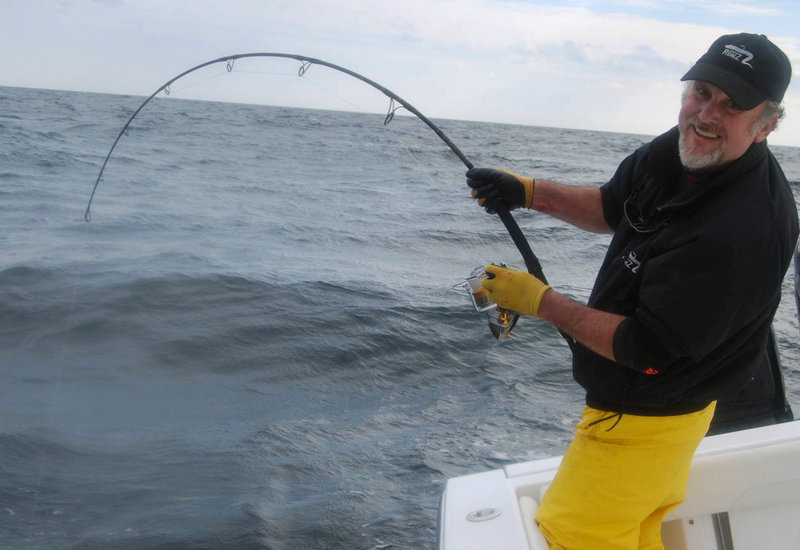CAMP LEJEUNE, N.C. – Ron Poirier couldn’t escape the feeling that his cancer was somehow a punishment.
As a young Marine electronics technician at Camp Lejeune in the mid-1970s, the Massachusetts man figured he’d dumped hundreds of gallons of toxic solvents onto the ground. It would be decades before he realized that he had unknowingly contributed to the worst drinking water contamination in the country’s history — and, perhaps, to his own premature death.
“It’s just a terrible thing,” the 58-year-old veteran told The Associated Press shortly before succumbing to esophageal cancer at a Cape Cod nursing facility on May 3.
“Once I found out, it’s like, ‘God! I added to the contamination.”‘
The cancer that killed Poirier is one of more than a dozen diseases and conditions with recognized links to a toxic soup brewing beneath the sprawling coastal base between the 1950s and mid-1980s, when officials finally ordered tainted drinking-water wells closed. As many as a million Marines, family members and civilian employees are believed to have been exposed to several cancer-causing chemicals.
In the final weeks of his life, it was not just cancer that was gnawing at Poirier.
The Brewster, Mass., man was with the 8th Communications Battalion at Lejeune from 1974 to 1976, working in a shop installing and repairing top-secret radio components. The shop was located just south of the Hadnot Point Industrial Area, right in the middle of a cluster of drinking water wells serving one of the base’s main residential sections.
There was plenty of suspicion about the possible health effects of handling and ingesting trichloroethylene, or TCE. But the U.S. Environmental Protection Agency had not yet established regulations for limiting exposure levels.
In a mid-March telephone interview from his home, Poirier said one of his jobs was to recondition circuit boards and other components. Working in a space with little or no ventilation, he used his bare hands to bathe the components in a pan of the TCE-laced cleaner or spray them down with an aerosolized version.
“It was also a great degreaser,” he said in halting tones, stopping often to catch his breath. “And it would leave the circuit boards absolutely clean.”
And it was cheap.
According to the manufacturer, the chemicals were to be used only once. Poirier chuckled when he recalled orders not to dump the stuff down the toilet, “because it would kill the bacteria” in the base’s septic system.
The only warning he could remember was not to dispose of the product beside buildings. So when he and his colleagues had filled a drum with used cleaner, they carried it across the parking lot and dumped it in the woods.
“Over the two years, how much did I dispose of?” he asked. “Christ. We used to go through 55 gallons in less than a month. So, you know, if I had to say a rough guess would be 100 gallons a month. … It was probably more. That’s a conservative figure.”
At one point, Poirier recalled, the EPA issued some guidance on TCE.
“And I remember the old-timers there saying, ‘That’s a bunch of bull. … We’ve been doing it this way for years,”‘ he said. “I was 18 years old. You did what you were told. You didn’t ask questions.”
Victims of the contamination note that there was a 1974 order governing the disposal of organic solvents and cleaning chemicals on the base.
Poirier left the Marines in 1976 as a sergeant, then spent six years with the Army.
Over the years, Poirier was surprised at the number of former Marine comrades who had died of cancer. With all the chemicals he’d handled during his lifetime, he said, “I thought maybe I was the lucky one.”
Then his luck ran out.
By the time doctors discovered the tumor in his throat, the cancer had already spread to other parts of his body. Poirier’s only option was chemotherapy.
At first, Poirier’s doctors at the Department of Veterans Affairs Hospital were baffled by his illness. He never smoked or drank to excess, and had quit both years earlier.
Then he learned about the Lejeune investigation, “and things started to make sense there.”
Esophageal cancer is one of 15 diseases or conditions listed under the Camp Lejeune Veterans and Family Act, which covers Marines and family members who were at the base between 1957 and 1987. Poirier’s disability claim “breezed right through,” and he had nothing but praise for the care he received through the VA.
Earlier this year, Poirier began having trouble walking. In mid-March, he learned the cancer had spread to his brain.
Within a week of speaking with the AP, Poirier had moved into hospice. He was later transferred to a skilled nursing facility, where he spent his final three weeks.
Send questions/comments to the editors.



Success. Please wait for the page to reload. If the page does not reload within 5 seconds, please refresh the page.
Enter your email and password to access comments.
Hi, to comment on stories you must . This profile is in addition to your subscription and website login.
Already have a commenting profile? .
Invalid username/password.
Please check your email to confirm and complete your registration.
Only subscribers are eligible to post comments. Please subscribe or login first for digital access. Here’s why.
Use the form below to reset your password. When you've submitted your account email, we will send an email with a reset code.